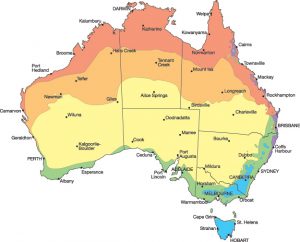Australian Climate Guide
Establish which coloured region you live in and then consider the varieties listed as typically suited to that area. The Australian Climate Guide map is intended as a guide only as climatic conditions vary between specific locations. Factors such as local altitude, wind and the proximity of hills, mountains and bodies of water can cause variations from the generalised climate map. Note also that although a plant may be listed as suitable for a particular region, it may still require protection from extremes such as frost or strong winds. You should also consider its requirements for sun, shade and water.
Remember that you can often extend the range of plants that you can grow by creating micro-climates within your garden. Planting under trees, beside brick walls or in the shelter of a building, on high or low points in the garden can all have an effect. Even planting by a pond or surrounded by rocks can be used to advantage. Part of the joy of gardening can be experimenting and nothing is more pleasing that achieving success with a plant that is not usually seen in your area.
The map is based on Australian Bureau of Meteorology 30 year climatology data from 1961-1990. The zones are based on both temperature and humidity:
 Tropical – hot humid summer .
Tropical – hot humid summer . Mild Tropical – warm humid summer
Mild Tropical – warm humid summer Semi-arid – hot dry summer, cold winter
Semi-arid – hot dry summer, cold winter Arid – hot dry summer, cold winter
Arid – hot dry summer, cold winter Temperate – warm summer, cool winter
Temperate – warm summer, cool winter Cool – mild-warm summer, cool winter
Cool – mild-warm summer, cool winter







